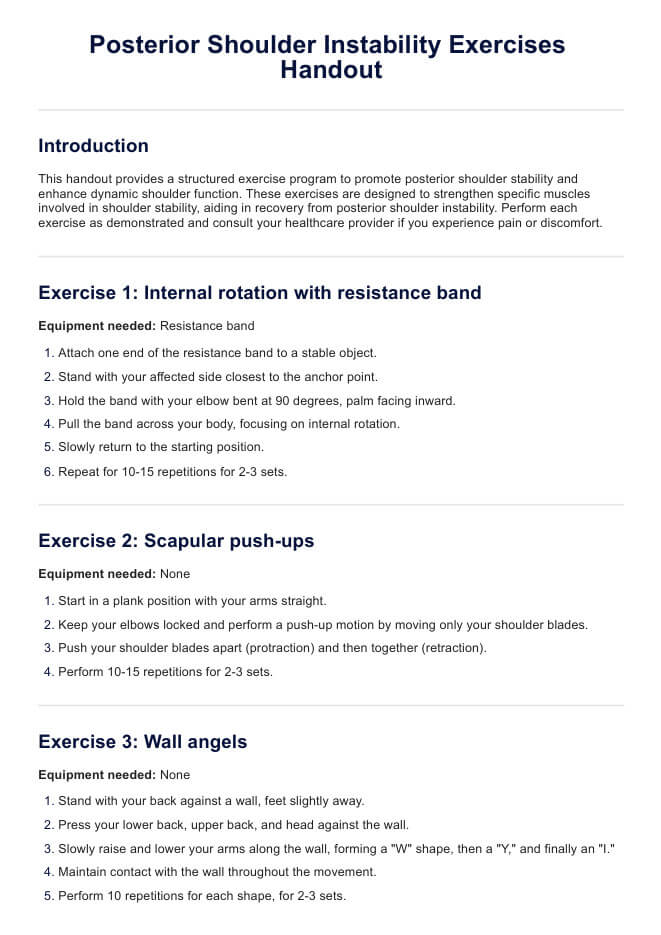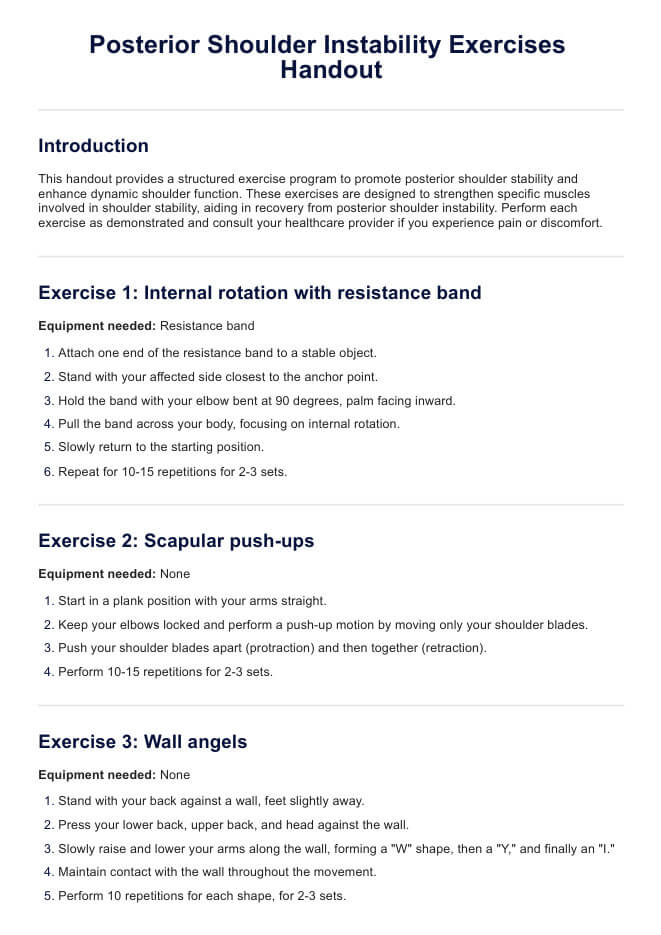Posterior Shoulder Instability Exercises Handout
Discover effective posterior shoulder instability exercises and examples in Carepatron's free PDF download. Strengthen and stabilize your shoulder with these targeted exercises.


Issues that contribute to posterior shoulder instability
Posterior shoulder instability can result from various factors that affect the shoulder's stability and function.
Recurrent posterior shoulder instability
Recurrent posterior shoulder instability occurs when the shoulder repeatedly dislocates or subluxates. This repetitive stress damages the surrounding tissues and structures, making the shoulder more susceptible to further instability and injury.
Compensatory mechanisms and altered kinematics
When the shoulder is unstable, the body often develops compensatory mechanisms and altered kinematics to maintain function. These changes can produce minimal muscle activation in the necessary stabilizing muscles, further contributing to instability and increasing the risk of injury.
Posterior rotator cuff issues
Insufficient posterior rotator cuff activation can lead to a lack of posterior rotator cuff stability in the shoulder joint. Proper rotator cuff activation is essential for maintaining proper rotator cuff stability, and inadequate muscle activation patterns can exacerbate instability issues. Moreover, weakness or injury to the rotator cuff muscles disrupts proper muscle activation patterns, leading to instability and dysfunction of the shoulder joint. Strengthening these muscles is crucial for improving shoulder stability and preventing further instability.
Posterior shoulder capsule issues
Damage or laxity in the posterior shoulder capsule can significantly contribute to posterior shoulder instability. The capsule helps maintain the integrity and stability of the shoulder joint, and any compromise in its structure can lead to an increased risk of dislocations and subluxations.
Brachial plexus pathologies
Brachial plexus pathologies involve damage or injury to the network of nerves that control muscle movements and sensation in the shoulder and arm. These conditions can lead to muscle weakness, loss of function, and reduced shoulder stability.
Posterior Shoulder Instability Exercises Handout Template
Posterior Shoulder Instability Exercises Handout Template
Importance of strengthening one's posterior shoulder
Strengthening the posterior shoulder is crucial for promoting stable posterior shoulder stability and overall shoulder health. Engaging in exercises that focus on the posterior shoulder helps maintain balance in the shoulder girdle muscles, including the mid trapezius. This balance is essential to prevent anterior shoulder stiffness, which can lead to discomfort and reduced mobility.
Proper internal rotation exercises are vital in this process, as they target the glenohumeral joint posterior capsule, enhancing its flexibility and strength.
Strengthening these muscles can also support recovery after rotator cuff repair surgery by encouraging postural muscular activation and ensuring the shoulder heals correctly. By focusing on the posterior shoulder, individuals can achieve better functional outcomes, reduce the risk of injury, and maintain optimal shoulder mechanics.
Overall, a strong posterior shoulder is integral to a balanced and stable shoulder joint to encourage postural muscular activation.
5 Exercises for shoulder stability
Strengthening shoulder stability is crucial for maintaining shoulder health and function. Physical therapists can incorporate these exercises into their patients' routines to promote posterior shoulder stability, enhance dynamic shoulder stability, and support proper muscle firing forms. Here are five effective exercises:
Internal rotation with resistance band
Equipment needed: Resistance band
Attach a resistance band to a stable object at waist height. Stand with your affected arm closest to the anchor point. Hold the band with your elbow bent at 90 degrees and pull it across your body, focusing on internal rotation. This exercise targets the rotator cuff and promotes posterior shoulder stability by enhancing the dynamic stability of the shoulder.
Scapular push-ups
Equipment needed: None
Start in a plank position with your arms straight. Keep your elbows locked and perform a push-up motion by moving only your shoulder blades. This activates the serratus anterior muscles and improves the stability of the scapula, crucial for advanced upper extremity function.
Wall angels
Equipment needed: None
Stand with your back against a wall, feet slightly away from the wall. Press your lower back, upper back, and head against the wall. Slowly raise and lower your arms, keeping them in contact with the wall. This exercise encourages proper muscle firing patterns and promotes posterior shoulder stabilization.
Prone T-Y-I raises
Equipment needed: Light dumbbells or none
Lie face down on an exercise bench. With your arms extended, lift them to form a "T" shape, then a "Y," and finally an "I." This targets the posterior shoulder muscles and the middle trapezius, enhancing overall shoulder stability and serratus anterior muscle activity.
External rotation with dumbbell
Equipment needed: Light dumbbell
Lie on your side with a light dumbbell in your top hand. Keep your elbow at a 90-degree angle and rotate your arm upward, focusing on external rotation. This exercise is essential for balancing internal rotation exercises and strengthening the rotator cuff for comprehensive shoulder stability.
How to use our Posterior Shoulder Instability Exercises Handout
Carepatron's Posterior Shoulder Instability Exercises Handout is a valuable resource for medical professionals aiming to guide patients through effective rehabilitation. These steps below ensure your patients achieve optimal results in shoulder musculature activation and dynamic shoulder stability.
Step 1: Assess the patient's condition
Before implementing any exercises, thoroughly evaluate the patient's shoulder condition. Identify the extent of posterior instability and any limitations in their range of motion. This assessment is crucial for tailoring the exercises to their specific needs and ensuring a safe starting point.
Step 2: Introduce the handout
Provide the patient with the Posterior Shoulder Instability Exercises Handout. Explain the purpose of the handout and how it will aid in their rehabilitation. Emphasize the importance of following the outlined exercises to achieve effective shoulder musculature activation and promote recovery.
Step 3: Demonstrate each exercise
Walk the patient through each exercise listed in the handout. Demonstrate the proper techniques and ensure they understand how to perform each movement correctly. Highlight the significance of implementing initial muscle activation to influence dynamic shoulder stability and avoid injury.
Step 4: Monitor progress and adjust
Regularly monitor the patient's progress and adjust the exercises as needed. Increase the intensity or complexity of the exercises gradually, based on the patient's improvement. This step ensures continuous improvement in active upper extremity elevation and overall shoulder function.
Step 5: Provide feedback and support
Offer ongoing feedback and support throughout the rehabilitation process. Encourage patients to ask questions and express any concerns. Positive reinforcement and professional guidance are key to maintaining motivation and ensuring adherence to the exercise regimen.
How will professionals benefit from using this handout?
Professionals will find Carepatron's Posterior Shoulder Instability Exercises Handout an invaluable tool for enhancing patient care and rehabilitation outcomes. This handout offers a clear, structured approach to addressing posterior shoulder instability, ensuring that patients follow evidence-based exercises designed to improve shoulder musculature activation and dynamic stability.
Through these standardized set of exercises, professionals can save time on creating individualized plans, allowing for more efficient use of clinical hours. Additionally, the handout serves as an excellent educational resource, helping patients understand the importance of each exercise and encouraging adherence to their rehabilitation regimen. This can lead to better patient engagement, quicker recovery times, and overall improved satisfaction with the care provided.
Ultimately, utilizing this handout supports a more organized and effective rehabilitation process, benefiting both the healthcare provider and the patient.
Commonly asked questions
Recovery time for a posterior shoulder dislocation varies but typically ranges from 6 to 12 weeks, depending on the severity of the injury and adherence to rehabilitation protocols.
To strengthen after a posterior shoulder dislocation, focus on gradual rehabilitation exercises that promote stability and range of motion, emphasizing posterior deltoid and rotator cuff strengthening.
Avoid exercises that excessively stress the shoulder blade or shoulder girdle musculature, such as overhead pressing, heavy lifting, and extreme external rotation, until cleared by a healthcare professional.
Precautions include avoiding sudden movements or activities that strain the shoulder, using proper lifting techniques, and wearing supportive gear during physical activities to prevent re-injury.







































































































